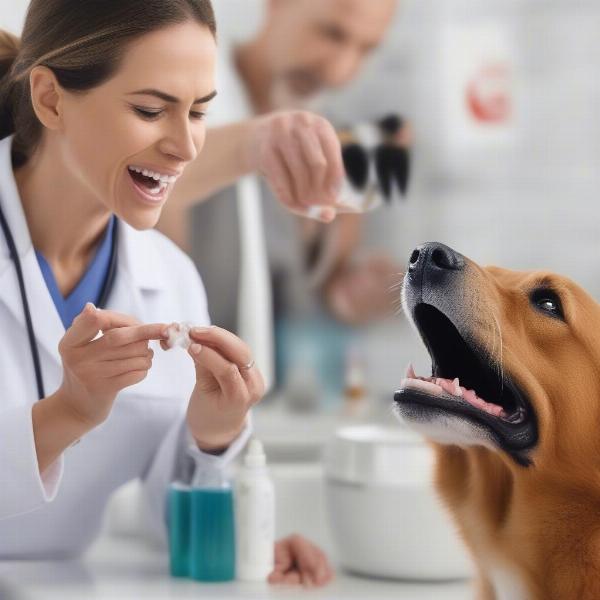Oral rinse, also known as dental rinse or mouthwash for dogs, is a valuable tool for maintaining your furry friend’s oral hygiene. It complements brushing and professional cleanings, helping to combat bad breath, plaque, and tartar buildup, contributing to overall better dental health. Choosing the right oral rinse and using it correctly can significantly enhance your dog’s oral care routine.
Understanding the Benefits of Oral Rinse for Dogs
Using oral rinse for dogs offers numerous advantages beyond simply freshening their breath. These rinses contain ingredients that work to break down plaque and tartar, the primary culprits behind gum disease and tooth decay. Regular use can help prevent these issues, reducing the risk of costly dental procedures and improving your dog’s overall well-being. Some rinses also contain antibacterial agents that fight harmful bacteria in the mouth, further protecting your dog’s dental health.
Choosing the Right Oral Rinse for Your Dog
Not all oral rinses are created equal. When selecting a rinse for your dog, look for products specifically formulated for canine use. Avoid human mouthwash, as it often contains ingredients like xylitol, which is toxic to dogs. Opt for rinses with enzymatic or chlorhexidine formulations, known for their effectiveness in plaque and tartar control. Consider your dog’s age, breed, and any existing dental conditions when making your choice. Consult your veterinarian for recommendations tailored to your dog’s specific needs.
 Choosing the Right Dog Oral Rinse
Choosing the Right Dog Oral Rinse
How to Use Oral Rinse for Dogs
Introducing oral rinse to your dog’s routine should be a gradual process. Start by offering a small amount on your finger for them to lick, allowing them to get accustomed to the taste. Once they’re comfortable, you can gradually introduce the rinse directly into their mouth. For best results, follow the instructions on the product label. Typically, you’ll add the recommended amount of rinse to your dog’s water bowl or administer it directly into their mouth using a syringe or specialized dispenser. Avoid forcing the rinse, as this can create negative associations. Positive reinforcement and patience are key to successful implementation.
Maintaining a Consistent Oral Care Routine
Oral rinse is most effective when used as part of a comprehensive oral care routine. Regular brushing is crucial for removing food particles and plaque. Professional dental cleanings are also essential for maintaining optimal dental health. flea shampoo for dogs helps ensure overall hygiene, while fresh breath for dogs can be achieved through a combination of brushing, rinsing, and dental treats. Incorporating these practices will contribute to your dog’s long-term dental health and overall well-being.
Conclusion
Oral rinse for dogs is a valuable addition to any oral hygiene regimen. By choosing the right rinse, using it correctly, and maintaining a consistent oral care routine, you can significantly improve your dog’s dental health, prevent future problems, and ensure fresher breath. Remember to consult your veterinarian for personalized advice and recommendations tailored to your dog’s individual needs. dental rinse for dogs can be a game-changer in your dog’s oral health journey.
FAQ
- Is oral rinse safe for all dogs? Most veterinarian-approved oral rinses are safe for dogs, but always check the label and consult your vet, particularly if your dog has pre-existing conditions.
- How often should I use oral rinse on my dog? Follow the instructions on the product label. Most rinses recommend daily or every other day use.
- Can I use human mouthwash on my dog? No, human mouthwash often contains xylitol, which is toxic to dogs. Always use a rinse specifically formulated for canine use.
- What are the signs of dental problems in dogs? Bad breath, excessive drooling, difficulty eating, swollen gums, and loose teeth are all potential indicators of dental problems.
- How can I encourage my dog to accept oral rinse? Start slowly, letting them lick a small amount from your finger. Gradually introduce the rinse into their mouth, using positive reinforcement.
- Are there any alternatives to oral rinse for dogs? Dental chews, treats, and water additives can complement oral rinse but shouldn’t replace regular brushing and veterinary checkups.
- What if my dog swallows the oral rinse? Most dog oral rinses are designed to be safe if swallowed in small amounts, but always consult your vet if you have concerns. oral antiseptic for dogs are generally safe if ingested in the recommended amounts.
ILM Dog is your comprehensive resource for all things dog-related. We offer expert advice on dog breeds, health, training, nutrition, grooming, and much more. Whether you’re a seasoned dog owner or just starting your journey, ILM Dog is here to support you every step of the way. Contact us today for personalized guidance on choosing the right products and services for your canine companion. Email: [email protected], Phone: +44 20-3965-8624. Visit ILM Dog for more valuable information and resources. dentisept for dogs is a product you may want to discuss with your veterinarian as part of a complete dental care plan.